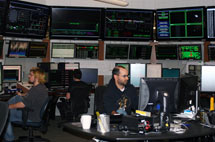
Handy Links
SLAC News Center
SLAC Today
- Subscribe
- Archives: Feb 2006-May 20, 2011
- Archives: May 23, 2011 and later
- Submit Feedback or Story Ideas
- About SLAC Today
SLAC News
Lab News
- Interactions
- Lightsources.org
- ILC NewsLine
- Int'l Science Grid This Week
- Fermilab Today
- Berkeley Lab News
- @brookhaven TODAY
- DOE Pulse
- CERN Courier
- DESY inForm
- US / LHC
SLAC Links
- Emergency
- Safety
- Policy Repository
- Site Entry Form

- Site Maps
- M & O Review
- Computing Status & Calendar
- SLAC Colloquium
- SLACspeak
- SLACspace
- SLAC Logo
- Café Menu
- Flea Market
- Web E-mail
- Marguerite Shuttle
- Discount Commuter Passes
-
Award Reporting Form
- SPIRES
- SciDoc
- Activity Groups
- Library
Stanford
Around the Bay
LCLS Beam Demonstrates Groundbreaking Flexibility
In the first 18 months of Linac Coherent Light Source operation, the electron beam that drives the X-ray laser has exceeded expectations—so much so that SLAC's accelerator operators can offer impressive flexibility in crafting the beam to suit experiments, often changing its performance in mere minutes.
This flexibility has been a revelation to scientists who are used to working at synchrotrons, where 20 or 30 experiments are under way at a given time and the beam operates the same way 24/7. "At synchrotrons, there's little, if any, communication between users and the control room unless something goes wrong with the beam," said XPP Instrument Scientist David Fritz. "You either have beam or you don't."
The LCLS today runs much more like a "laser in the lab," where experimenters can request variations in photon wavelength, per-pulse energy and pulse duration—sometimes on an hourly basis as they explore new scientific possibilities.
To prepare for this sort of nimble operation, accelerator operators first meet with instrument scientists and users every Wednesday afternoon to discuss the upcoming week's experiments. A representative from each experiment offers a short overview of the experiment, followed by the beam parameters they expect to request.
"Then it's a lot of phone calls back and forth to change parameters or just check how things are going," said Mike Stanek, deputy head of the LCLS Accelerator Operations and Safety Division. That happens fairly regularly as the experiments progress or as users determine how to further optimize them. "As they've seen that changes are quick and not risky, it seems that maybe they're more likely to ask for parameter changes more often," Stanek said. Fritz agrees. "Users are usually a little surprised by how free the communication is between the hutches and the control room," he said. "We're constantly calling back and forth at the beginning of experiments. It's pretty amazing some of the things they can do for us. These are things you never had any control over at synchrotrons and users are rapidly taking advantage of the new capabilities."
In addition to the flawless and quick parameter changes, instrument scientists say that they've been impressed by the quickness of the accelerator operators and their Accelerator Directorate colleagues to see an experimental need and find a way to offer new capabilities that address it. "We like to check in to see how things are going and talk about what else we could be doing for them," said Rick Iverson, former run coordinator and current area physicist for the Beam Switch Yard and Linac to Undulator transport line. Just one of many such interactions began when one of the instrument scientists asked whether it would be possible to slowly vary the wavelength of the X-rays over time in a sinusoidal pattern. Engineering Operator-in-Charge Danielle Sanzone recognized the importance of such a scanning capability and found a way using existing MATLAB tools in the control system to satisfy the request within minutes. The program has proven useful in several different experiments already, Stanek said.
A quick glance at the machine parameters on the LCLS site reveals not only the long list of variable parameters, but also an ever-changing list of parameters under development. "Here we share with users essentially what's on the menu and also what we hope will soon be on the menu," Iverson said.
These developments, which are thanks not only to the accelerator operators but also to the many other groups who have worked hard to make a 49-year-old machine reliable and nimble, allow users to expand their experiments, gathering more and often higher quality data than they might otherwise have attained. For example, at the Soft X-ray Materials Science beamline, the ability to reach soft X-ray energies as low as 480 eV means that operators can tune the beam to be absorbed by both cobalt and oxygen—two energy levels the LCLS was not originally designed to reach—adding tremendous flexibility. The real-time capacity to change parameters, combined with a very reliable beam, has been critical to the success of the first LCLS experiments.
"Starting in run 1, we asked for operating conditions that no one even anticipated—longer or shorter pulses, energy changes—and the machine provided much more flexibility, much earlier than expected," said Christoph Bostedt, instrument scientist for the Atomic, Molecular and Optical instrument. "It's been an experiment on all sides, and it's really been a success."
"I admire the machine guys for really pushing the envelope," added SXR Instrument Scientist Bill Schlotter. "The community had an expectation for how the machine will run, and that's been completely obliterated."
—Kelen Tuttle
SLAC Today, March 2, 2011
